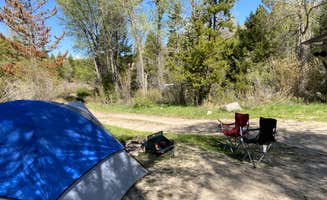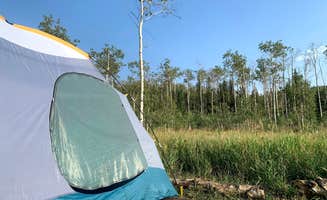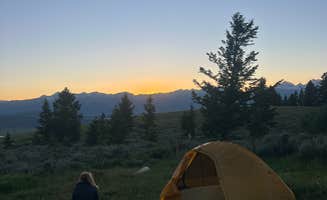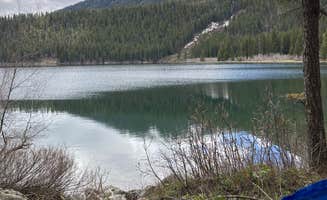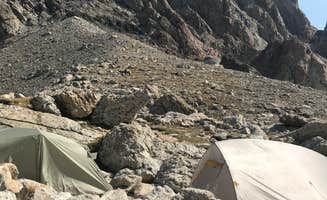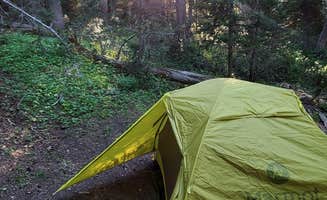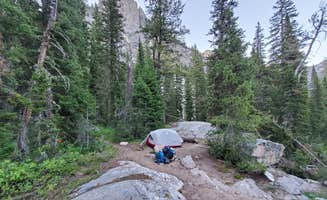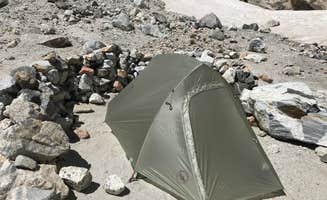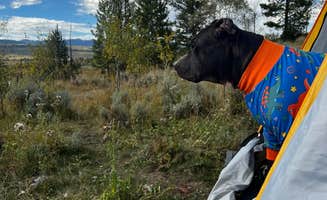Tent camping near Kelly, Wyoming takes place at elevations between 6,600-7,800 feet, requiring preparation for significant temperature fluctuations. Summer nights typically drop below 45°F even when daytime temperatures reach the 80s. The camping season runs primarily from late May through September, with some dispersed sites accessible into October depending on snowfall.
What to do
Wildlife photography opportunities: Campers at Shadow Mountain Dispersed Camping can capture stunning photos of local wildlife against mountain backdrops. "We woke up to cows breakfasting around our RV!" reports one visitor to Buffalo Valley. Early morning and dusk provide optimal wildlife viewing times, particularly for elk and moose.
Fishing in nearby streams: Access multiple fishing spots within a short drive of tent sites. "We walked down to the creek for some fishing," shares a visitor at Curtis Canyon Dispersed Camping. Local streams contain cutthroat trout and require Wyoming fishing licenses, available at stores in Jackson for $14 daily or $92 for non-resident seasonal permits.
Waterfall exploration: Visit cascades accessible from camping areas. "Pull off on RIGHT small area with a beautiful waterfall fed pond!" notes a camper at Phillips Bench Trailhead. Most waterfall hikes range from 1-3 miles round-trip, with peak flow occurring in June during snowmelt season.
What campers like
Private beach access: Some tent sites offer exclusive water access. "I was lucky enough to get a spot with its own private beach," notes a camper at Taylor Ranch Road Dispersed Camping. These areas provide cooling opportunities during hot summer days and photography settings at sunset.
Well-maintained tent pads: Many established campgrounds feature level spots for tents. "Site 7 tent pad is more tucked away and has bigger space. Close to restrooms and trails," reports a camper at Jenny Lake Campground. Most tent pads measure approximately 10'x10' and remain usable even after rain.
Night sky viewing: The minimal light pollution creates exceptional stargazing opportunities. "Cool stars, no one around, nothing but you and your campsite surrounded by nature," writes a visitor to Buffalo Valley Designated Dispersed Camping. The Milky Way becomes clearly visible approximately 90 minutes after sunset on clear nights, with best viewing between 11pm-2am.
What you should know
Bear safety requirements: All camping areas require proper food storage. "We locked up all our food in a sturdy cooler in the cab of the truck and had no problems," explains a camper at Buffalo Valley Designated Dispersed Camping. Bear boxes are provided at designated sites, but dispersed campers must bring appropriate containers.
Seasonal insect activity: Bug protection becomes essential during summer months. "The mosquitoes were terrible so we opted to sleep in the car for the night," reports a visitor to Buffalo Valley. Insects typically peak from mid-June through August, with activity decreasing after sunset as temperatures drop.
Road conditions to remote sites: Access to some tent camping spots requires navigating rough terrain. "Road is rough. Recommend high clearance vehicles," notes a visitor describing Taylor Ranch Road access. Most dispersed sites become challenging to reach after rainfall, with roads drying within 24-48 hours in summer conditions.
Tips for camping with families
Choose sites with natural play features: Look for camping areas with safe exploration options. "We backed in between the trees for privacy and had a perfect, small area to ourselves," describes a visitor to Shadow Mountain. Most family-friendly sites offer flat areas for games and short nature walks.
Plan for temperature fluctuations: Nights become significantly colder than days. "Although it rained for two days at the Grand Tetons, camp was amazing! Big spots, lots of trees for shade," shares a visitor to Colter Bay Tent Village. Children require additional layers as evening temperatures can drop 30-40 degrees from daytime highs.
Look for educational opportunities: Rangers often provide programs for younger campers. "The camp host was friendly and the sites were clean. You are a 30 second to two minute walk from Jenny Lake with fishing, hiking trails, or a boat ride," notes a Jenny Lake visitor. Most ranger programs run 30-45 minutes and cover topics from wildlife to geology.
Tips from RVers
Limited hookup availability: Most areas near Kelly focus on tent camping with few RV accommodations. "We knew it was a Friday night, and we could hear even more partying down the road, but we still wished for peace and quiet," reports a camper at Shadow Mountain describing the social atmosphere at more accessible RV-friendly areas.
Site arrival timing: Popular spots fill quickly, particularly on weekends. "We arrived around noon on a Sunday and landed spot #9, which was pretty epic," shares a visitor to Antelope Springs Designated Dispersed Camping. Most RV-accessible sites fill before noon during peak season (July-August).
Generator restrictions: Many camping areas prohibit generator use to preserve the natural soundscape. "Colter bay....where to relax after Yellowstone and much more accessible," notes an RVer, highlighting the value of established campgrounds with amenities over dispersed sites for those needing power. Generator hours at campgrounds that permit them typically run 8am-8pm.


